What is a Sales Strategy?
A Sales Strategy guides your sales team to position your company and its products and services to your ideal target customers in a meaningful, differentiated way.
A well-defined sales strategy is your path to sustainable growth.
A winning sales strategy should deliver:
- Clear goals everyone can work toward
- Clear priorities everyone can understand
- Clear outcomes everyone can be measured by
- Clear guidelines everyone can follow
If a Sales Strategy does not deliver on these factors, sales teams and sales leaders tend to make decisions based on what seems best at the moment.
Having a big picture strategy keeps sales teams and leaders aligned to the business's goals, irrespective of a good month of sales or a bad one for that matter.
Unified big picture thinking is critical to keep everyone rowing in the same direction.
7 Steps to build a modern Sales Strategy
- Create an ideal customer profile
- Set a clear Go-to-Market (GTM) strategy
- Sales and Marketing Alignment (SLA)
- Assess performance and set a clear revenue & action plan
- CRM & Pipeline management
- Reporting, analytics & data visualisation
- Inbound & outbound sales strategies
1. Create an Ideal Customer Profile
We’ve all had that call come in. The one where the prospective sale sounds like a done deal. You get all powered up and set a meeting for the next day.
But when you do have the meeting, your hopes are dashed when you soon realise that there is no way they are going to be able to afford what you are selling.
Moreover, you also realise they’re in an industry that is not well suited to your product. You have a meeting. It’s a complete waste of time.
An ideal customer profile (ICP) provides guidelines for your salespeople that helps them spend their time efficiently on prospects who are most likely to convert and deliver repeat business.
We all have a good idea of who our ICP is, but a good exercise is to run some data and look at your previous sales.
Figure out:
- Who spent the most money?
- What industry are they in?
- Who bought more than one product?
- Who was the easiest to work with?
- Which client had the shortest sales cycle?
For most companies, 80% of revenue comes from 20% of clients.
Dive into the demographics and psychographics of your ideal customer and create a profile for your salespeople.
A good ideal customer profile must:
- Enable your salespeople to identify a good prospect quickly.
- Allow anyone to describe the ICP to someone else in such a way that they can find other ICPs.
Good examples of an ideal customer profile:
- Chief Marketing Officers in technology companies doing $30m or more in revenue.
- Heads of Sales in the finance industry with teams larger than 30.
- CEOs of international manufacturing companies with offices in 2 or more countries.
2. Set a clear Go-To-Market (GTM) strategy
You’ve defined your ideal customer profile, so it's now time to think about what you are going to take to these ICPs and where you are going to find high concentrations of them.
Let’s start by defining what a Go-To-Market strategy is.
A go-to-market (GTM) strategy is the way a business takes a product to market. It is a plan outlining the target audience, marketing plan, and sales strategy. A great GTM maps out a market problem and offers a market solution.
Why is a GTM strategy important?
A defined GTM strategy gives everyone in the sales and marketing teams a plan to work from. It means that everyone in the sales team will be selling strategically and importantly in the correct way.
How often are salespeople hired and asked to go sell a product or service without an inkling of a go-to-market strategy? All too often.
Think about how ridiculous this is. Management wants the new sales recruit to start hitting target as quickly as possible, but the recruit must figure out how to make it happen themselves.
Unless the salesperson is a complete self-starter and sales pro, he or she is going to find it hard to hit target in the timeframe management is expecting.
People need guidelines to work to and salespeople are no exception. Importantly product training is not a go-to-market strategy.
Follow these 3 steps to put your Go-To-Market strategy in place.
Step A: Create a value matrix built around pain points
The best way to do this is to highlight the pain point of your target persona.
Everyone is looking to solve their pain points. Even if they haven’t yet articulated them. So identify them for your ICP.
When we sell CRM and sales efficiencies baked into CRM systems this is part of the value matrix we use:
| User Pain Point | User Product Value | User Message |
|
|
|
| Decision Maker Pain Point | Decision Maker Product Value | Decision Maker Message |
|
|
|
Once you’ve identified your value matrix, start pushing this messaging out on your advertising channels and through your sales team.
Work with your marketing team to see which messaging is getting the highest click through.
Your marketing department should be able to tell you if you have high clicks in certain industries and then dive deeper into company size, geography and job function.
Using this data will help you direct your sales team's efforts.
We’ll talk about working with your marketing team in the next section.
Step B: Create a Buyer’s Journey Map
There are a number of people involved in the stages of making a purchase.
According to the Harvard Business Review, the number of people involved in the decision-making process has increased from 5.4 two years ago to 6.8 today.
These stakeholders come from a wide range of roles, functions, and geographies.
Selling effectively today needs a GTM strategy that takes into account these 6.8 people. We call this the buying centre. There are roughly seven broad roles in the buying centre.
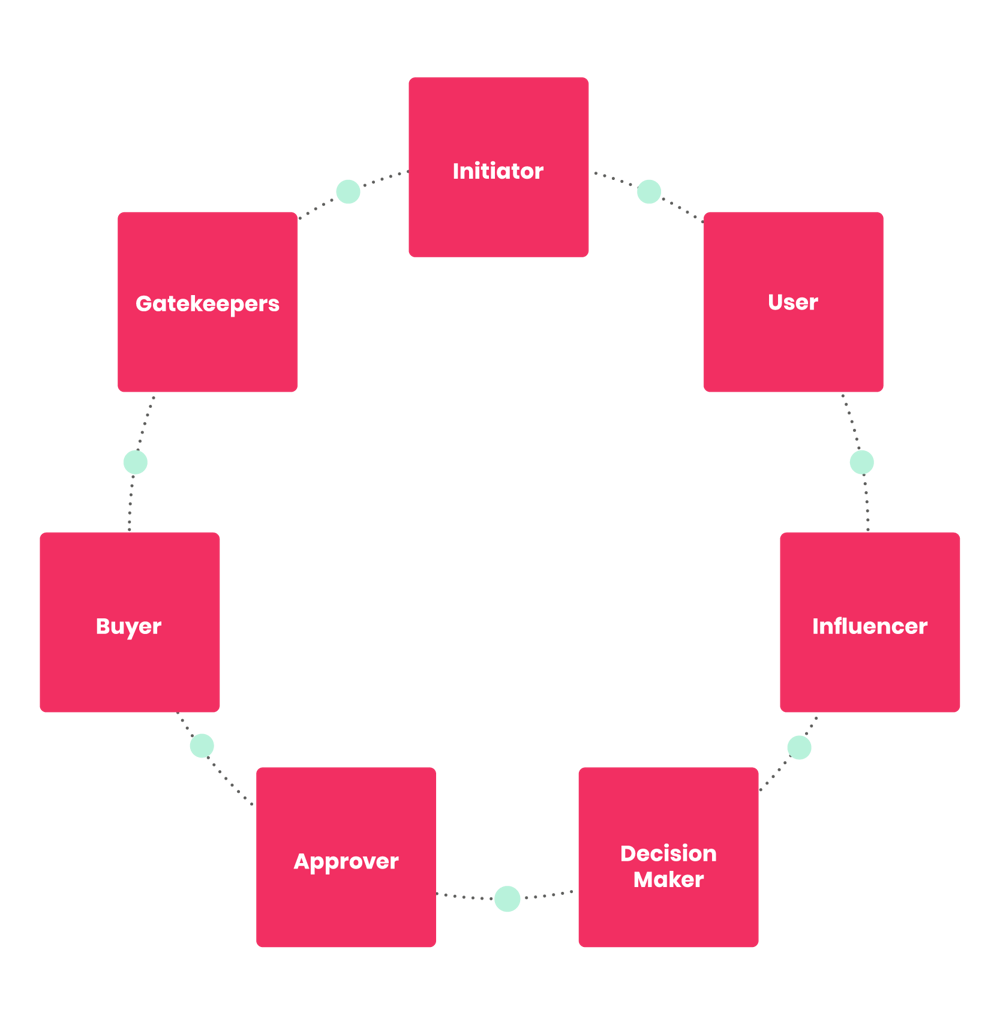
Understanding these people and what each needs during the process helps create the right content and strategies you’ll need to make the sale.
Again, when we are selling CRM systems and sales efficiencies, this is what our own buyer’s centre looks like:
- Initiator - Salesperson/Sales manager
- User - Salesperson
- Influencer - Sales operations
- Decision Maker - Sales director/manager
- Approver - Managing director/CEO
- Buyer - CFO
- Gatekeeper - IT admin
Step C: Follow the Buyer’s Journey Map
Now that you understand your value matrix and you have created your buyer’s journey map, follow the map. This means you need to delve deeply into how a potential customer will journey from not being aware of your company at all, to becoming a customer.
To do this we look at the buyer’s journey which largely follows this process:
- Firstly, they realise they have a problem and actively or passively seek out solutions.
- Then the buyer shortlists potential solutions by online and referral-based research.
- The shortlist is whittled down to two or three solution providers, and then a purchase decision is made.
From the business’s perspective, the buyer’s journey is a funnel with three distinct stages. At each of the stages, engagement is driven by different tools.
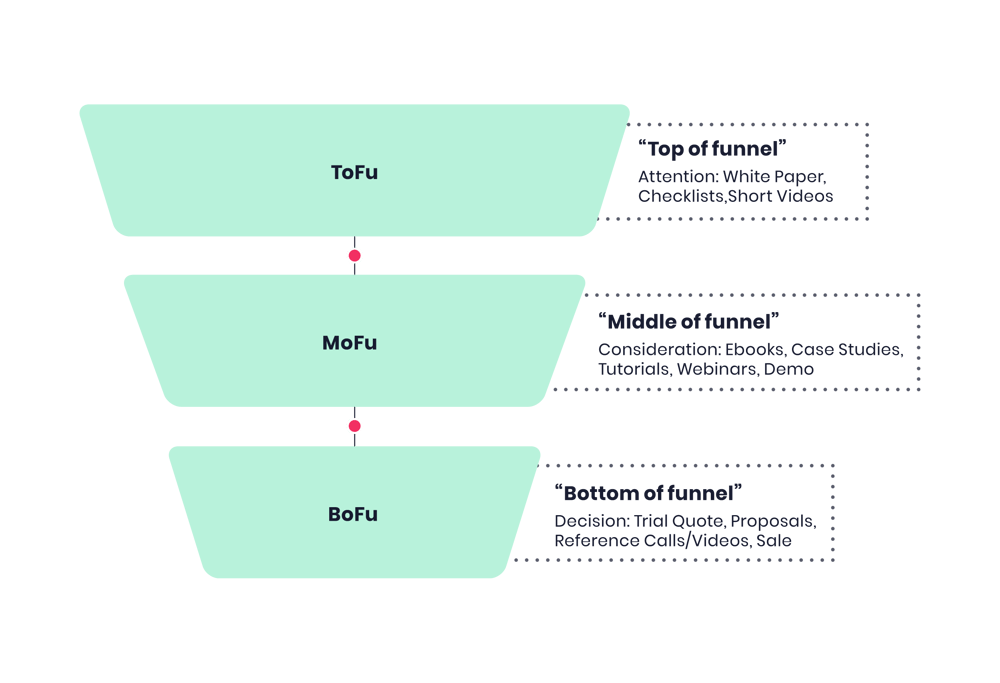
ToFu: Top of the funnel - Attention: White Paper, Checklists, Short Videos
Generally, the top of the funnel is driven by articles, videos, checklists and tool downloads, which all lead to extensive pieces of content containing videos and testimonials to get attention.
A lead lands here by clicking an ad on social media, a social media post, or a well-ranked search engine result.
This process is driven largely by the marketing team.
MoFu: Middle of the funnel - Consideration: Ebooks, Case Studies, Tutorials, Webinars, Demo
The middle of the funnel is driven by eBooks, case studies, live chat and demos to answer key questions lead might have.
The role of sharing this material with prospects is split between both the sales and marketing teams.
BoFu: Bottom of the funnel - Decision: Trial Quote, Proposals, Reference Calls/Videos, Sale
The bottom of the funnel is driven by salespeople and product specialists in one to one product walk-throughs, solution scoping and pricing negotiations to close the sale.
This process is driven by the sales team.
It is very important to know where your prospect is in the buyer’s journey and feed them the right information at the right time. Doing this speeds up the process and moves it closer to closing.
Sharing the wrong information at the wrong time can unsettle a prospect, confuse them and make them nervous to move the project forward.
At this point, you may have noticed we are starting to talk about the marketing team. We know for many sales teams, marketing is often not usually trusted to deliver help in the sales process.
That being said, read on. We see the role of marketing in the modern sales strategy is critical.
In the next section, we explain why, and how the two teams can work well together.
3. Sales and Marketing Alignment (SLA)
This is a slightly longer section but stay with me because it’s a really important concept.
If you’re in sales, I’m sure you’ve heard this one before...
“The leads that the marketing department send over are really poor quality. They are a waste of time to follow up.”
You may be surprised to hear that there is a similar conversation going on over in the marketing department.
“Sales never follow up on our leads properly. We send leads over and hear nothing. Then when they close deals they think they did all the work and marketing never get recognition.”
This polarisation makes is very hard for sales to close leads from marketing and marketing to improve lead quality. There is, however, a solution. It’s called a Sales and Marketing SLA.
But before I expand on what this SLA is, let me explain to you - the sales professional - why you need the marketing team more than ever.
Power has shifted in today’s purchasing process
When I started in sales, my sales manager dumped a Yellow Pages on my desk on my first day and told me to get calling. 100% outbound. 100% cold calling. This doesn’t work anymore.
The power has shifted to the buyer. The explosion of information available on the internet has allowed buyers to research what they want and need long before they talk to a salesperson.
Buyers today research independently. They then select the vendors they wish to engage with, and only then reach out to two or three of them.
When that buyer calls in they are pre-qualified and the salesperson has at least a 33% chance of closing them. (Provided they are an ICP of course.)
This shift in power makes the marketing team a critical part of the modern sales process. The sales strategies that work hand in hand with marketing will win.
According to HubSpot, companies with formalised Sales and Marketing SLAs are:
- 34% more likely to experience greater year-over-year ROI
- 21% more likely to get greater budget allocations
- 31% more likely to be hiring additional salespeople to meet demand
- 4X as likely to say their marketing is effective
Ok, so what is a Sales and Marketing SLA?
SLAs are commonplace when signing on new customers. But they are a little foreign between departments in the same business.
A Sales and Marketing SLA agrees on the marketing goals, like the number of qualified leads delivered, the sales activities that will follow up and support them, and the feedback between the teams.
The sales and marketing teams will both use this document as a guide to support each other in their core functions of sales and marketing.
If they are off track the other team can call them out and hold them accountable.
The end result is a relationship between both teams that starts to synergise and accelerate results for both sides.
4. Assess Sales Performance and Set a Clear Revenue & Action Plan
The next step in your sales strategy is to look at current and historical performance. With that data, a clear revenue plan and action plan needs to be developed.
Once you have the data on hand, you need to answer the list of questions below:
Macro and general business factors
- What is the growth rate in the current economy (national, provincial, city)?
- What is the growth rate in your industry?
- What was your company’s revenue growth rate last year?
- What revenue growth can be expected this year?
- What is the stretch growth rate target?
Account, territory and product/service factors
- How much growth can you extract from your existing accounts?
- How many referral leads can you get from existing accounts?
- How much can you increase revenue with existing products in your current territory?
- How much can you increase revenue with new products in your current territory?
- How much can you increase revenue with existing products in new territories?
- How much can you increase revenue with new products in new territories?
Is it reasonable that the fastest revenue to generate will be from existing accounts? Are referrals a quick way to generate revenue?
Our experience has shown that the slowest and most expensive new revenue will result from sales for new products in new regions.
However, if you are in a saturated and highly competitive market, this might be the only way to hit the revenue growth numbers.
How to get started
Our recommendation is to start this sales strategy process with account plans for your top 10 clients.
This will be aimed at growing your revenue with them as well as actually using these current clients to develop your referral base.
By understanding at a base level where you did well in past periods, you can forecast future performance and identify where to focus your sales efforts. This is simple to do once you have the required data.
If your team has been given a sales target equating to a 10% increase in the last period, you need to create an action plan that guides your team's focus to achieve the target.
The “Spray and Pray” method in today's competitive market will not cut it. Focus on the industries, territories and products that are more likely to bring growth.
5. CRM & Pipeline Management
A sales pipeline in a modern CRM shows the sequence of steps your salespeople need to take to move a contact from a prospect to a customer. These steps are based on your own sales process.
All pipelines are custom to a company, but they all largely follow a similar core structure. A contact in the pipeline moves from stage to stage until they either fall off the pipeline or are closed and become a customer.
Modern CRMs show the sales pipeline in a visual roadmap for your sales team. At any given point in time, the pipeline makes it transparent where in the buying process a prospect is.
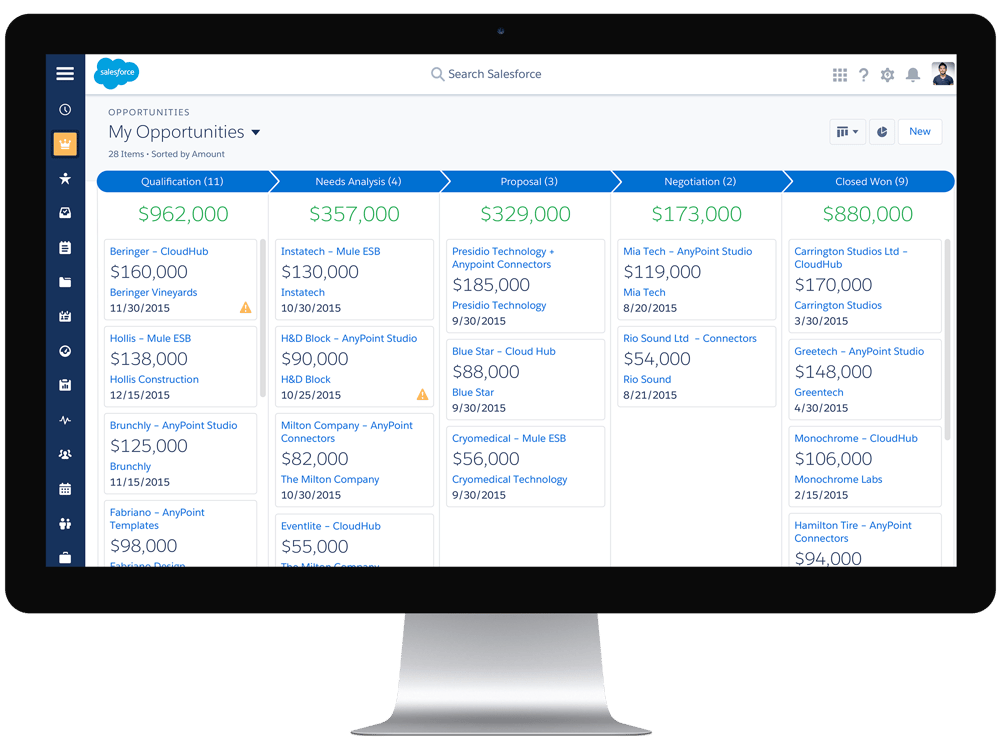
This allows salespeople and managers to create realistic revenue forecasts as they will be able to easily see how many opportunities are pending, what probability of closing they have, and how many of those might close in a given timeframe.
Define the stages of your sales pipeline
The stages of your sales pipeline (also called your sales cycle) will depend on multiple factors including, your business model, your sales process and your products and services.
Some businesses might have a sales pipeline for each department, some might have a pipeline for each product or service, and for some businesses just a single pipeline for the entire business is adequate.
The most common stages of a sales pipeline include:
Prospect > Connect > Qualify Lead > Present Offer > Closed Won > Generate Referral
But, it can also look like this:
Prospect > Connect > Appointment > Qualify Lead > Product Demo > Solution Design > Present Offer > Closed Won
Or this (This is our own ‘New business’ pipeline),
Prospecting > Appointment Scheduled > Needs Analysis > Qualified to Buy > Presentation Schedules > Decision Maker Bought In > Quotation Presented > Signaled Intent to Sign > Closed Won
Your pipeline needs to reflect your sales process’s unique requirements.
You need to establish a clear baseline of how many opportunities generally move from one pipeline stage to the next.
This analysis will give you a solid idea of how many opportunities you need to target in each stage to hit your revenue number.
Having a defined process enables you to see the patterns, and if you can see the patterns you can improve the process to optimise ROI on your sales efforts.
Centralised data and reporting
In addition to solidifying your sales process, a CRM will give you a central place to locate all your sales communications and metrics.
This moves us onto reporting, Analytics & Data Visualisation.
6. Reporting, Analytics & Data Visualisation
It’s very hard to keep track of the success of your sales strategy without the use of data and analytics.
Sure, you can look at the sales numbers as they come in from finance. If you’re lucky, at your company they filter through to you within a few days. However, this is not normally the case.
The problem with looking at the numbers after that fact is they are trailing indicators. You find out at the end of the week, month, quarter, and year when you are behind target and need to catch up.
Realtime data
Using a CRM with a reporting capability to report sales data on the fly is the key here.
We use HubSpot CRM, but the same thing can be done with Salesforce CRM and a number of other good CRM’s.
Below is a screenshot of one of our pipelines, this data is presented realtime and we can tell at any stage whether we out in front or behind on our sales target.
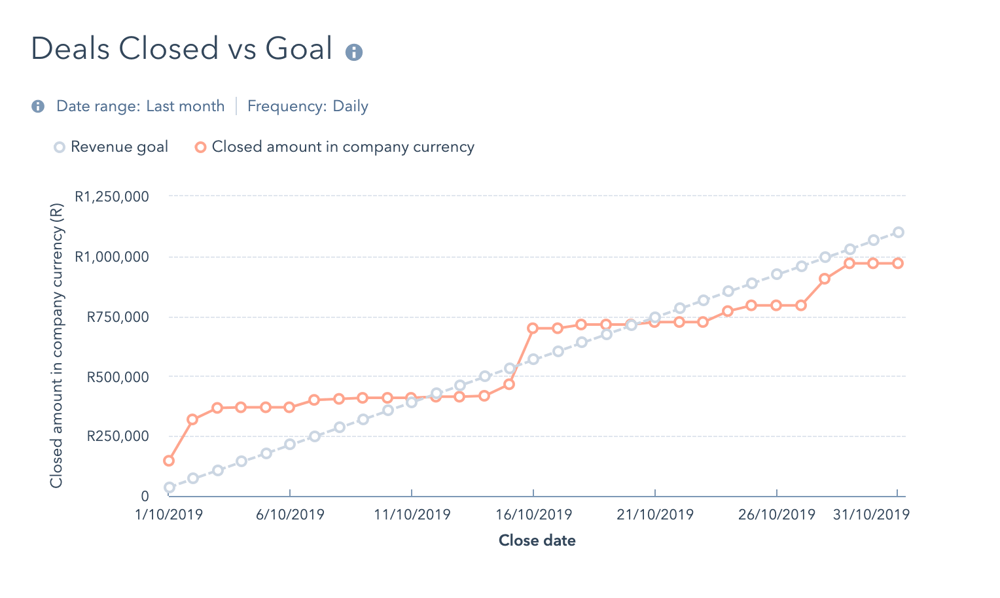
Talking about leading indicators, one of the most important factors is sales activity.
Sales activities are meetings, deal, contacts created, emails sent, etc. With sales, high levels or activity leads to revenue numbers on the board.
Below we can see how many emails our sales team sent out over the month. We can also see how many tasks they set for themselves and which ones are completed. It looks like it was a good month of activity.
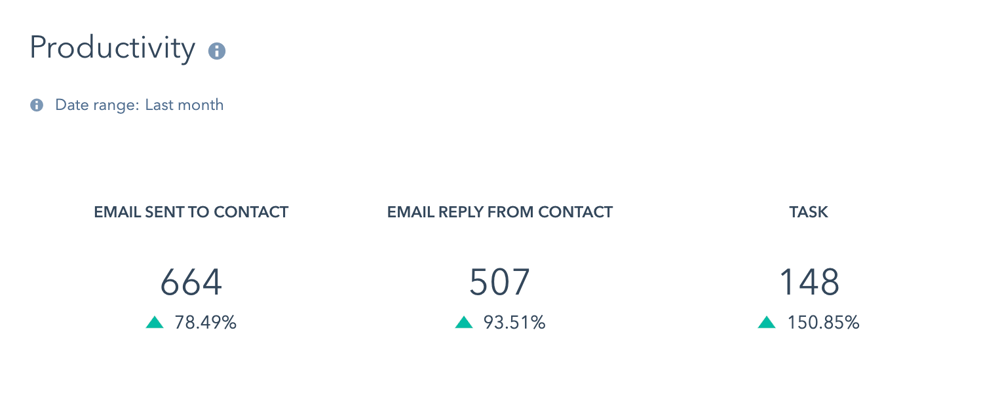
If we look below, CONTACTS CREATED, it shows us that the sales team and marketing teams are reaching out to lots of new contacts every month. CONTRACTS WORKED shows us how many contacts have been nurtured during the month.
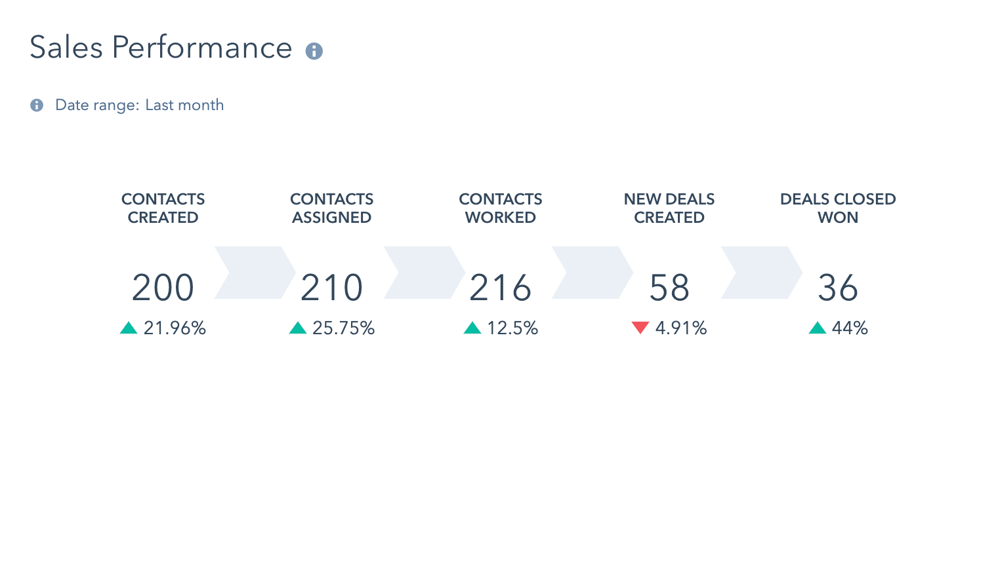 Once a sales strategy has been set, it is critical to track how the sales and marketing teams are tracking to the activity goals they have been set. This is how we track progress on the action plan we set out in section 4 above.
Once a sales strategy has been set, it is critical to track how the sales and marketing teams are tracking to the activity goals they have been set. This is how we track progress on the action plan we set out in section 4 above.
Using a range of dashboards and data analytics that talk to the sales strategy, we can give sales managers and anyone responsible for the numbers in business a real time snapshot of the sales strategy.
7. Inbound & Outbound Sales Strategies
Looking at the figure of 200 CONTACTS CREATED in our dashboard above, these contacts were created by a joint effort between the sales and marketing teams.
Key, however, is that not all of these contacts are ready to be sold to now.
So, the question is: How do you fill your sales pipeline by grabbing the attention of your target audience that is ready to buy now?
This is done with a combination of Inbound and Outbound strategies.
What is an Inbound Sales Strategy?
Broadly the domain of the marketing team, with inbound, prospects will discover your company through your marketing efforts and reach out to you or show signs of interest organically.
Examples of organic inbound traffic channels could be social media, content, or paid ads leading to a landing page. On that landing page, the prospect needs to leave their email address behind in exchange for a valuable piece of content that is designed to solve their core pain points.
We use landing pages like the one below to generate lists of prospects. The prospects give us their contact details in exchange for a download. In this case they receive an infographic on Marketing Automation.
Before the lead is passed onto sales the marketing team will decide if the lead should be passed on to sales (Sales Qualified Lead), or whether marketing should continue to carry on nurturing the lead (Marketing Qualified Lead).
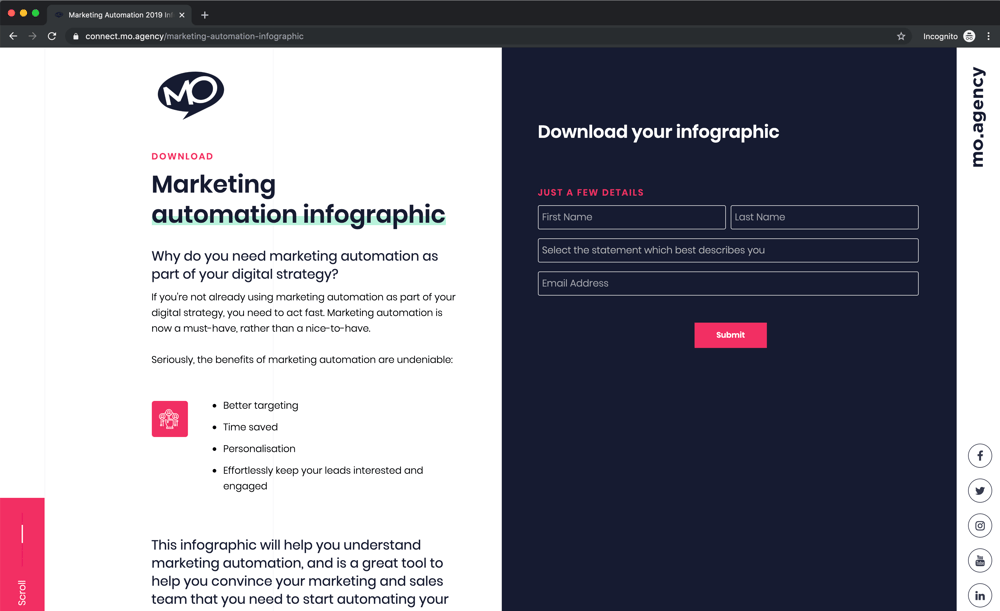
What is an Outbound Sales Strategy?
The domain of the sales team, outbound lead generation is when a salesperson contacts a lead through cold outreach tactics.
The sales team might to this by reaching out to a contact list, sending warm emails, phoning leads, or gathering leads at industry conferences.
Once interest has been generated through these methods, sales conversations begin, and the leads are fed more educational content and then moved into the sales funnel.
Leads that are not ready to close now, are handed over to the marketing team to nurture into a sales-ready state that we call a Sales Qualified Lead.
When the lead becomes sales-ready and indicates they are ready to buy, by coming back to the website or downloading a new guide, the marketing department alerts the sales team and hands the lead back over to be closed by sales.
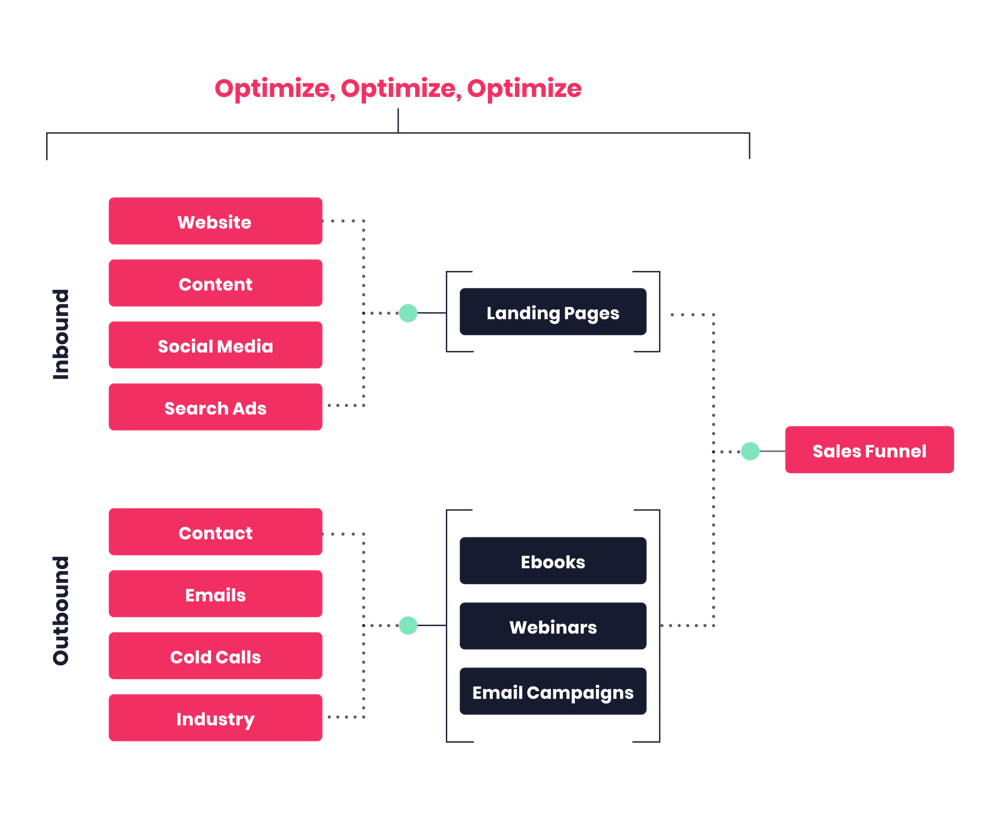
Sales enablement
To add to the sales team's outbound efforts, it is important for the marketing team to share the eBook and value-adding assets with sales. By using these assets the sales team can engage with their prospects by sharing valuable content.
With this content salespeople can avoid that all to common call...
'Hey Bob, just checking in to see if you are ready to move ahead with your purchase.'
Answer: 'Thanks for calling again... But I'm not ready. Call me next year.'
Follow up with a useful share of content.
'Hey Bob, our product team just released this really great comparison of CRM software. I think this might help you with your decision process.'
Answer: 'Thanks! That's super useful. I'll let you know what I we decide next week.
Sharing valuable content positions your salespeople as experts and advisors. This is the type of company any buyer would prefer to do business with.
Final thoughts
Without a Sales Strategy a sales team will find it hard to hit their targets.
A winning sales strategy should deliver:
- Clear goals everyone can work toward
- Clear priorities everyone can understand
- Clear outcomes everyone can be measured by
- Clear guidelines everyone can follow
If you would like to find out how to operationalise your Sales Strategy by using sales and marketing technology reach out to us. We will give you scalable sales processes that will supercharge your sales results and give you real time visuals on your team and individual sale performance.
Click on the chat or go to the contact us page.






